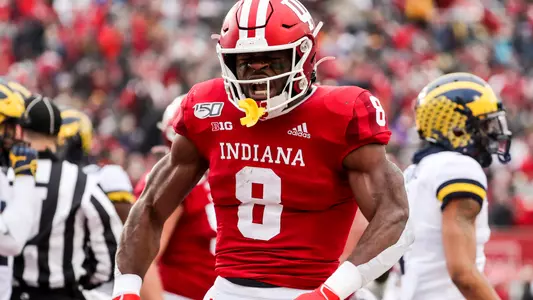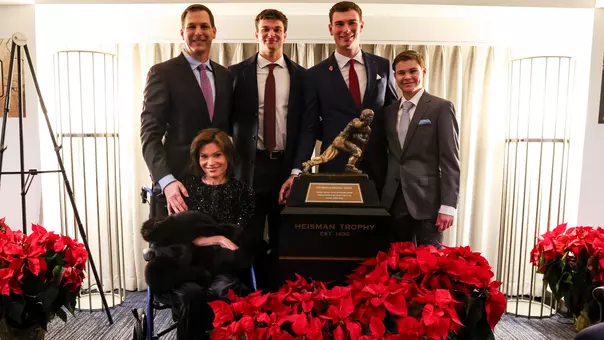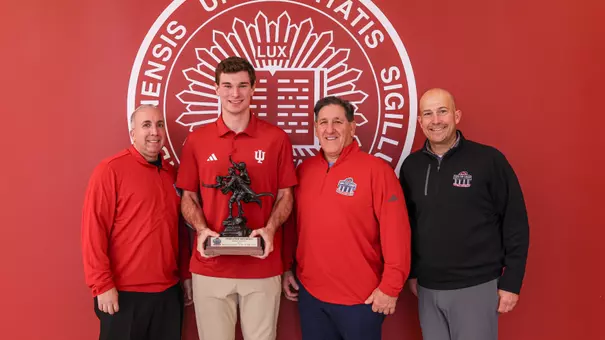Indiana University Athletics

Details Matter -- IU Plans For Safe Player Return
6/8/2020 9:30:00 AM | Football
By Pete DiPrimio
IUHoosiers.com
BLOOMINGTON, Ind. – James Naismith would understand -- to a point.
All he had to do was invent basketball.
Indiana's medical and athletic officials have to figure out a way to safely return and train athletes in a pandemic.
"I often refer to this as this is like coaching a new sport that's never been invented," says Andy Hipskind, IU's chief medical officer.
"There's no season. There's no previous season from last year to go on. There's no scouting report to go on. So, while we continuously scour the science and the literature and the studies we can, a lot of this is just evolving."
The goal for college athletics, as it is for so many things worldwide, is return to normal, or as close to normal as possible, as soon as it's safe to do so.
When and how are among the questions everyone is asking
With the NCAA allowing a return to voluntary workouts, universities are devising plans, starting with football and men's and women's basketball.
Nothing, Hipskind emphasizes, is etched in stone.
"We're going to have to make adjustments on the fly, but we feel like we have a good robust plan in place."
Is it risk free? Of course not, but neither is going to the grocery store, or anyplace outside the house amid coronavirus concerns
"While we can't guarantee safety," Hipskind says, "there is some risk tolerance to this, so everybody is accepting a certain level of risk. We can guarantee we will have an up-to-date, technologically advanced system in place, and that we'll have the latitude to make adjustments based on science, based on trends, based on how it's going at our individual campus level, to making the adjustments to ultimately reduce the risk and take the necessary precautions to keep them as safe as possible."
It's a multi-step challenge -- bring players, coaches and staff back to campus, test to ensure everyone is healthy, and keep them that way while training players at the elite level necessary for Big Ten competition.
Hipskind says "anybody involved in working out" will sign a pledge to agree to social distancing, hygiene and sanitation. It will acknowledge they've been educated in the process and understand their responsibilities.
The plan calls for 68 football players to return this week. Two weeks later, 25 players will come back. Two weeks after that, it's everyone else.
"There's a lot we don't know," head coach Tom Allen says. "The first two-week period will give us a lot of good feedback and information. We'll use that to make things better and make sure we're doing it the right way."
Players, coaches and staff will be tested for the coronavirus before being allowed into IU's facilities. Everyone will then be quarantined for a couple of days until results are in.
The coronavirus carries unique challenges. Some people have the virus and get really sick, some moderately so, and some show no symptoms, but can infect others.
"We will do an entry test," Hipskind says. "We will test every athlete. The idea is that there's probably a 25 to 50 percent asymptomatic infection rate. Those are people that actually have the infection, but do not have symptoms to warn them that they have it.
"So, with that asymptomatic rate, we want to know that we are not putting anybody into the facility that could be an asymptomatic carrier.
"We also know that young people, because they seem to get the symptoms in a milder nature than the older population, that of that 25 to 50 percent asymptomatic carrier range, a majority of that comes from the younger population."
Once players are cleared, they will be divided into groups of 10 -- nine players and a strength coach. In medical terms, that's a "cohort," Hipskind says.
As far as determining who's in each group, it will start with roommates. It will not be organized so that, say, all the running backs or all the receivers would work out together.
"So if you did have somebody get the virus," Allen says, "it doesn't spread to the entire (position) room."
Adds Hipskind: "We would try to get the kids who are roommates to also be in the same workout group. You keep people in these cohorts to help limit spread if there were to be a positive case. That exposures to other people would be limited because they would live and work out and train within these cohorts."
The strength and conditioning staff, athletic trainers and coaches will work together to monitor and ensure every guideline is followed.
Memorial Stadium's state-of-the-art weight room, among the largest in the country, can handle two groups at a time.
"Our weight room is large enough," Allen says, "that we can have the east and west side to have 10 on each side."
Outside workouts also would be divided into groups of 10 so "There's no interaction with guys and they're socially distanced," Allen says. "They will not be in contact with each other."
Workouts will be scheduled around summer classes, which are online.
"We'll have the latitude to adjust different things as we see fit in terms of new science coming out," Hipskind says. "Maybe a new recommendation will come out, potentially something logistically is working better than others. We will be able to do some adjusting on the fly."
Through all of this, IU officials have been in constant contact with players and parents -- emails, phone calls, texts and Zoom meetings -- to ensure everyone knows what's going on, all the guidelines and safety measures.
"It's been a pretty thorough process of trying to communicate from the very beginning," Allen says. "We open it up to anytime you have any questions at all, feel free to share any concerns that you have.
"Because the communication has been good, thorough and consistent, we've had very few (parents) say, 'Hey I don't want my son coming back. I don't feel safe. I don't feel he's going to be safe'. No one has said that or felt that way."
The goal, Allen adds, is to, "Educate and inform so they feel good that we're doing everything we can do. You can't say that there's zero risk. You can't say that. There's risk in everything that we do. But you do everything at a high level of preparation and you follow all the medical experts and (use) the best practices."
Allen says "I don't have the answers yet" about what happens in July and afterward.
"You let (parents and players) know these are fluid situations."
For those who have questions, position coaches are available at any time. So are Mike Pechac, director of player development, Mike Doig, director of football operations, and Kyle Blackman, head athletic trainer.
"We communicate over and over so they feel good about it," Allen says. "When they have questions, they know they have easy access to get answers."
Once players and coaches are together, they will be limited to "essential travel" to minimize the risk of exposure and infection. Those who leave will fill out a questionnaire upon returning to determine location and who they came in contact with. Doctors and athletic trainers will evaluate "on a case-by-case basis," Hipskind says.
"We know there will be circumstances when athletes will have to travel. The definition of essential has a broad range of interpretation."
IU officials want to identify those who "might be coming from a hot spot."
"It's important where they come from," Hipskind says. "Anybody who displays symptoms, they get quarantined and tested."
IUHoosiers.com
BLOOMINGTON, Ind. – James Naismith would understand -- to a point.
All he had to do was invent basketball.
Indiana's medical and athletic officials have to figure out a way to safely return and train athletes in a pandemic.
"I often refer to this as this is like coaching a new sport that's never been invented," says Andy Hipskind, IU's chief medical officer.
"There's no season. There's no previous season from last year to go on. There's no scouting report to go on. So, while we continuously scour the science and the literature and the studies we can, a lot of this is just evolving."
The goal for college athletics, as it is for so many things worldwide, is return to normal, or as close to normal as possible, as soon as it's safe to do so.
When and how are among the questions everyone is asking
With the NCAA allowing a return to voluntary workouts, universities are devising plans, starting with football and men's and women's basketball.
Nothing, Hipskind emphasizes, is etched in stone.
"We're going to have to make adjustments on the fly, but we feel like we have a good robust plan in place."
Is it risk free? Of course not, but neither is going to the grocery store, or anyplace outside the house amid coronavirus concerns
"While we can't guarantee safety," Hipskind says, "there is some risk tolerance to this, so everybody is accepting a certain level of risk. We can guarantee we will have an up-to-date, technologically advanced system in place, and that we'll have the latitude to make adjustments based on science, based on trends, based on how it's going at our individual campus level, to making the adjustments to ultimately reduce the risk and take the necessary precautions to keep them as safe as possible."
It's a multi-step challenge -- bring players, coaches and staff back to campus, test to ensure everyone is healthy, and keep them that way while training players at the elite level necessary for Big Ten competition.
Hipskind says "anybody involved in working out" will sign a pledge to agree to social distancing, hygiene and sanitation. It will acknowledge they've been educated in the process and understand their responsibilities.
The plan calls for 68 football players to return this week. Two weeks later, 25 players will come back. Two weeks after that, it's everyone else.
"There's a lot we don't know," head coach Tom Allen says. "The first two-week period will give us a lot of good feedback and information. We'll use that to make things better and make sure we're doing it the right way."
Players, coaches and staff will be tested for the coronavirus before being allowed into IU's facilities. Everyone will then be quarantined for a couple of days until results are in.
The coronavirus carries unique challenges. Some people have the virus and get really sick, some moderately so, and some show no symptoms, but can infect others.
"We will do an entry test," Hipskind says. "We will test every athlete. The idea is that there's probably a 25 to 50 percent asymptomatic infection rate. Those are people that actually have the infection, but do not have symptoms to warn them that they have it.
"So, with that asymptomatic rate, we want to know that we are not putting anybody into the facility that could be an asymptomatic carrier.
"We also know that young people, because they seem to get the symptoms in a milder nature than the older population, that of that 25 to 50 percent asymptomatic carrier range, a majority of that comes from the younger population."
Once players are cleared, they will be divided into groups of 10 -- nine players and a strength coach. In medical terms, that's a "cohort," Hipskind says.
As far as determining who's in each group, it will start with roommates. It will not be organized so that, say, all the running backs or all the receivers would work out together.
"So if you did have somebody get the virus," Allen says, "it doesn't spread to the entire (position) room."
Adds Hipskind: "We would try to get the kids who are roommates to also be in the same workout group. You keep people in these cohorts to help limit spread if there were to be a positive case. That exposures to other people would be limited because they would live and work out and train within these cohorts."
The strength and conditioning staff, athletic trainers and coaches will work together to monitor and ensure every guideline is followed.
Memorial Stadium's state-of-the-art weight room, among the largest in the country, can handle two groups at a time.
"Our weight room is large enough," Allen says, "that we can have the east and west side to have 10 on each side."
Outside workouts also would be divided into groups of 10 so "There's no interaction with guys and they're socially distanced," Allen says. "They will not be in contact with each other."
Workouts will be scheduled around summer classes, which are online.
"We'll have the latitude to adjust different things as we see fit in terms of new science coming out," Hipskind says. "Maybe a new recommendation will come out, potentially something logistically is working better than others. We will be able to do some adjusting on the fly."
Through all of this, IU officials have been in constant contact with players and parents -- emails, phone calls, texts and Zoom meetings -- to ensure everyone knows what's going on, all the guidelines and safety measures.
"It's been a pretty thorough process of trying to communicate from the very beginning," Allen says. "We open it up to anytime you have any questions at all, feel free to share any concerns that you have.
"Because the communication has been good, thorough and consistent, we've had very few (parents) say, 'Hey I don't want my son coming back. I don't feel safe. I don't feel he's going to be safe'. No one has said that or felt that way."
The goal, Allen adds, is to, "Educate and inform so they feel good that we're doing everything we can do. You can't say that there's zero risk. You can't say that. There's risk in everything that we do. But you do everything at a high level of preparation and you follow all the medical experts and (use) the best practices."
Allen says "I don't have the answers yet" about what happens in July and afterward.
"You let (parents and players) know these are fluid situations."
For those who have questions, position coaches are available at any time. So are Mike Pechac, director of player development, Mike Doig, director of football operations, and Kyle Blackman, head athletic trainer.
"We communicate over and over so they feel good about it," Allen says. "When they have questions, they know they have easy access to get answers."
Once players and coaches are together, they will be limited to "essential travel" to minimize the risk of exposure and infection. Those who leave will fill out a questionnaire upon returning to determine location and who they came in contact with. Doctors and athletic trainers will evaluate "on a case-by-case basis," Hipskind says.
"We know there will be circumstances when athletes will have to travel. The definition of essential has a broad range of interpretation."
IU officials want to identify those who "might be coming from a hot spot."
"It's important where they come from," Hipskind says. "Anybody who displays symptoms, they get quarantined and tested."
FB: Fernando Mendoza - Heisman Trophy Press Conference (12/15/25)
Monday, December 15
FB: Curt Cignetti - Pre-Heisman Press Conference
Wednesday, December 10
FB: Fernando Mendoza - Pre-Heisman Press Conference
Tuesday, December 09
FB: CFP Quarterfinals (Rose Bowl) - Student-Athlete Press Conference
Monday, December 08




